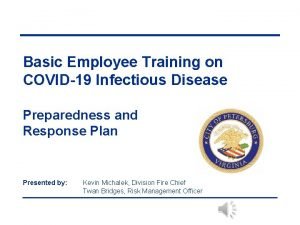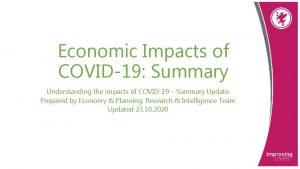Economic Impacts of COVID19 Summary Understanding the impacts















- Slides: 15

Economic Impacts of COVID-19: Summary Understanding the impacts of COVID-19 – Summary Update Prepared by Economy & Planning: Research & Intelligence Team Updated 04. 08. 2020

60, 0 Feb 1997 Oct 1997 Jun 1998 Feb 1999 Oct 1999 Jun 2000 Feb 2001 Oct 2001 Jun 2002 Feb 2003 Oct 2003 Jun 2004 Feb 2005 Oct 2005 Jun 2006 Feb 2007 Oct 2007 Jun 2008 Feb 2009 Oct 2009 Jun 2010 Feb 2011 Oct 2011 Jun 2012 Feb 2013 Oct 2013 Jun 2014 Feb 2015 Oct 2015 Jun 2016 Feb 2017 Oct 2017 Jun 2018 Feb 2019 Oct 2019 • UK GDP fell 19. 1% in the three months to May, with falls in both March and April. • Weekly hours worked decreasing by 16. 7% from March to May, the largest fall on record. • The number of employees on payroll declined by 2. 2% from March to June. 100, 0 90, 0 80, 0 70, 0 Sources: ONS, Monthly GDP Estimate , Labour Market Overview June 2020 800 Mar-May 1992 Feb-Apr 1993 Jan-Mar 1994 Dec-Feb 1995 Nov-Jan 1996 Oct-Dec 1996 Sep-Nov 1997 Aug-Oct 1998 Jul-Sep 1999 Jun-Aug 2000 May-Jul 2001 Apr-Jun 2002 Mar-May 2003 Feb-Apr 2004 Jan-Mar 2005 Dec-Feb 2006 Nov-Jan 2007 Oct-Dec 2007 Sep-Nov 2008 Aug-Oct 2009 Jul-Sep 2010 Jun-Aug 2011 May-Jul 2012 Apr-Jun 2013 Mar-May 2014 Feb-Apr 2015 Jan-Mar 2016 Dec-Feb 2017 Nov-Jan 2018 Oct-Dec 2018 Sep-Nov 2019 Economic activity and output have fallen Total actual weekly hours Worked 1100 1000 900 Monthly GDP Index, Feb 1997 -May 2020 110, 0 Number of employees on PAYE 29500000 29000000 28500000 28000000 27500000 27000000 26500000 26000000 25500000 июл-14 июл-15 июл-16 июл-17 июл-18 июл-19

National claimant count has risen sharply, whilst job postings have dropped precipitously UK Unemployment Rate, seasonally adjusted, 16 yrs and over, April 2019 to June 2020 4, 50% 4, 00% 3, 00% 2, 50% 2, 00% 1, 50% un ay 201 -J 9 Ju ul 2 n 0 Au 19 g Ju 2 l-S 019 ep Au g- 201 O 9 Se ct 2 p 01 No 9 Oc v 2 0 t-D 19 e No c 2 v- 01 9 Ja De n 2 02 c. Fe 0 Ja b 2 n 0 M 20 Fe ar 2 02 b. A M pr 0 ar 2 -M 02 ay 0 20 20 1, 00% r-J • 3, 50% M • • Interest in unemployment data is high, but its reliability is an issue Job postings have fallen dramatically Unemployment rate remains steady, but only captures those seeking work, which is largely unavailable. Claimant count has increased significantly, but overestimates unemployment, as claimants not necessarily out of/or seeking work. Ap • Source: Office for National Statistics – Labour Market Overview For more info on issues pertaining to unemployment data please refer to our COVID-19 Bulletin

Somerset claimant counts have risen sharply since March, but dipped slightly in June • There has been a steep rise in the claimant count across Somerset since March, with 5% of Somerset’s working age population claiming out-of-work benefits in June. Somerset had consistently lower claimant rates than the national average before the crisis and this remains the case. Please Note: Claimant count figures do NOT provide a direct measure of unemployment and claimant conditionalities were relaxed in response to the COVID-19 crisis. • • Mar - 20 April - May - June 20 20 20 Cumulative Increase Mendip 2. 3 4. 5 5. 6 5. 3 3. 0 Sedgemoor 2. 8 4. 7 5. 6 5. 4 2. 6 Somerset West & Taunton 2. 2 4 4. 9 4. 7 2. 5 South Somerset 1. 9 3. 8 4. 7 4. 6 2. 7 Somerset 2. 3 4. 2 5. 1 5. 0 2. 7 South West 2. 2 4. 3 5. 4 5. 2 3. 0 United Kingdom 3. 0 5. 1 6. 4 6. 3 3. 3 Claimant Count as a Proportion of Residents 7, 0 6, 0 5, 0 4, 0 3, 0 2, 0 19 20 e 20 Ju 19 ly Au 20 1 Se gus 9 t 2 pt em 01 be 9 Oc r 20 to 1 No ber 9 ve 2 m 019 De ber 2 ce m 019 be Ja r 20 nu 19 a Fe ry 2 br 0 ua 20 ry M 202 ar ch 0 2 Ap 020 ril 20 2 M ay 0 20 2 Ju ne 0 20 20 M Ju n ay 20 19 19 20 ril Ap 19 M ar ch 20 ry ua br Fe Ja n ua ry 20 19 0, 0 Mendip Sedgemoor SWT Somerset South West United Kingdom South Somerset Source: NOMIS, Claimant Count by Sex and Age (non-seasonally adjusted)

29% of the UK's workforce was furloughed as of the 30 th of June, with some industries seeing a bigger impact than others Furlough Statistics • As of June 30 th, 9. 4 million employments had been placed on furlough nationally, an increase of 678, 000 compared with claims made until the end of May. • Furlough take-up levels are highest amongst the arts, entertainment and recreation industry (73%), and the arts entertainment and recreation industry (66%). Return from Furlough • • Of businesses continuing to trade, 8% of their workforce had returned from furlough in the last two weeks, while 4% had returned from remote working to the normal workplace. Of businesses continuing to trade, in addition to those intending to restart trading in the next two weeks, 6% of the workforce are expected to return from furlough in the next two weeks, while 4% are expected to return to their normal workplace from remote working. National Furlough Take-Up Rate by Industry (June 30 th) 73% Accommodation & food services 66% Arts, entertainment, recreation and other services 59% Construction Wholesale and retail; repair of motor vehicles 40% Manufacturing 40% 34% Property 31% National Average Business administration and support services 30% Transport & storage (inc postal) 30% Mining, quarrying & utilities 30% Professional, scientific & technical 27% Waste and Recycling 23% Agriculture, forestry & fishing 20% Information & communication 17% Energy Production 15% Health 10% Education 9% Finance & insurance 7% Public administration & defence 1% 0% 10% Source: Coronavirus & the Economic Impacts on the UK, 16 th July 20% 30% 40% 50% 60% 70% 80%

2. 6 million claims have been made to the SEISS nationally, with the Construction Industry dominating overall claims SEISS Statistics • By 30 th June 2. 6 million of the potentially eligible population (75%) had claimed a SEISS grant with the value of these claims totalling £ 7. 4 billion. This compares to 2. 4 million claims made and £ 7 billion claimed by 31 st May. • Around 90% of claimants are aged between 25 and 64 and take-up of the grant in those age groups is at or above 75%. No one age group dominates and claims are evenly spread • Nationally the industries with most claims are construction (801, 000); transportation and storage (206, 000); service activities (178, 000); and administrative and support services (177, 000). This data is not yet available at a Somerset level. • As demonstrated by the chart, SEISS claims have been dominated by the construction sector nationally, with the sector making up 34% of the total value of claims to the scheme. Source: HMRC, Self-Employment Income Support Scheme Statistics The construction industry has dominated claims to the SEISS scheme Proportion of total value of claims to SEISS nationally - 30 th June 34% Construction Transportation and storage 9% 8% Administrative and support service activities Other service activities 7% Professional, scientific and technical activities 5% Wholesale and retail trade; repair of motor vehicles and motorcycles 5% Human health and social work activities 4% Education 4% Arts, entertainment and recreation 3% Manufacturing 2% Agriculture, forestry and fishing 2% Accommodation and food service activities 2% Information and communication 1% Financial and insurance activities 1% Real estate activities 0% Public administration and defence; compulsory social security 0%

Employment support schemes have largely insulated the labour market until now • • • As of the 30 th of June, 74, 600 employments had been furloughed in Somerset (a take-up rate of 30%), representing an increase of 10, 200 since the end of May. As of 30 th June, 24, 600 self-employed people in Somerset had claimed income support (72% of those eligible), an increase of 1, 500 since the end of May. As these support schemes are wound down, we are likely to see unemployment rise, with increased levels of redundancies. Number of Somerset residents claiming self-employment income support as of 30 th June Furlough Take-Up Rate Across Somerset (June 30 th) 40% South Somerset 38% 6900 36% 34% Somerset West and Taunton 32% 30% 28% 31% South West UK 30% Mendip 29% 29% Sedgemoor Somerset West and Taunton South Somerset Source: HMRC, Coronavirus Job Retention Scheme Statistics 6600 Sedgemoor 5100 Mendip 5900 0 1000 2000 3000 4000 5000 6000 7000 8000

More than 500 reported redundancies as of 24 th July Company Area Number of redundancies Mulberry Chilcompton (Mendip) 265 at risk Clarks Street (Mendip) 100 Relyon Wellington (SWa. T) 82 Swallowfield (KDC/One) Wellington (SWa. T) 40 Food Manufacturer Mendip 21 Leisure Business Mendip 25 Please Note: • The above are tentative figures, with some unconfirmed/subject to ongoing consultation. • Some redundancies were already planned prior to the COVID-19 pandemic. • Some companies have been anonymised for confidentiality purposes.

Trading status, financial performance and business resilience have all been impacted by the pandemic Businesses are re-opening in large numbers; but some sectors face bigger challenges than others. Trading Status: • The latest ONS Business Impact Survey from the period 29 th of June to the 12 th of July reported 93% of businesses nationally are continuing to trade, while 7% reported they had temporarily closed or paused trading, with around 1% having permanently ceased trading. • The arts entertainment and recreation industry had the highest proportion of businesses not intending to restart in the next two weeks (29. 4%), with accommodation & food services second at 12. 7%. • In most industries, 87% or more of businesses were currently trading and had been for more than the last two weeks. In addition, of businesses reported re-opening in the last two weeks, the accommodation & food services sector reported the largest percentage at 33%, followed by the arts, entertainment & recreation sector at 14%. Financial Performance • Of businesses continuing to trade, 57% nationally reported a decrease in turnover outside of normal range, whilst 11% reported that turnover had increased. • Industries reporting the highest percentage of decreased turnover of more than 50% were the arts, entertainment and recreation industry (42. 7%) and the accommodation and food service industry (41. 8%) • The sector which had the highest percentage of business reporting increased turnover was the wholesale and retail trade (22%). Business Resilience • The accommodation & food services sector had the highest percentage of businesses nationally indicating they only had cash reserves to last between 0 -6 months (54. 6%) followed by the construction and arts, entertainment and recreation sector (both 52%) • The education sector and the information and communication sector reported the highest percentage of businesses indicating they had cash reserves to last more than six months (49% each).

There are significant challenges for many sectors, although these impacts are varied Retail: • The wholesale & retail trade has struggled markedly as a result of lockdown measures. Rolling three-month growth rates from March to May indicate that nationally the sector shrank by 23. 7%. The sector did contribute the most to services growth in May however, increasing by 1. 51%. • National retail sales data however documented a slight recovery in May, with an increase in sales of 12% compared to record falls in the previous month. Accommodation & Food Services: • This industry saw the largest contraction in three-month growth rates from March to May, shrinking by 71. 7% nationally. The sector grew by 0. 01% in its contribution to service growth in May. • On Exmoor, 89% of accommodation businesses had temporarily ceased all trading from responses gathered in May-June. Health & Social Care Activities • This industry shrank by 24. 2% nationally in the three-month rolling rate from March to May, although the industry’s contribution to services growth did turn positive for the first time since March, growing by 0. 07%.

The manufacturing, construction and agricultural industries have also faced challenges nationally Manufacturing • Manufacturing contracted by 18% nationally from March to May, with the most notable contraction in the manufacture of transport equipment (-45. 7%) due to many factories being closed. • Manufacturing did however grow by 8. 4% in May, with 11 of 13 sub-sectors increasing, however this is still 22. 3% lower than the Feb 2020 level. • Regionally, the SWMAS barometer has highlighted the challenges of the pandemic for manufacturing, with 80% of respondents reporting a fall in production volumes. Construction • This industry shrunk nationally by 29. 8% from March to May, a record fall. The largest contributors to this fall were private new housing & private commercial (-42. 5% & -29. 5%). • Construction grew by 8. 2% in May, however the level of output remains 38. 8% lower than February 2020. Agriculture • Agriculture shrank by 6. 3% nationally from March to May, with this industry facing a fairly unique set of challenges during the pandemic. • Many farmers have been unable to access grants due to agricultural property not being rateable, with Government loan schemes often bumping up against state aid restrictions.

Forecasts suggest significant loss of output and jobs in 2020 and recovery 'bounce-back' in 2021, but a potential for long-term 'scarring' Headline Figures Oxford Economics forecasts: • An 8% contraction in Somerset’s GVA in 2020, along with 10, 000 job losses, with unemployment peaking at 5%. • A rise of 7. 4% GVA and 2. 5% in employment by 2021. Sector Analysis • Accommodation & Food sector projected to lose a substantial 3500 jobs in 2020 compared to 2019. The arts, entertainment and recreation industry is forecast to lose 1500 jobs in 2020 • Manufacturing is forecast to lose 2000 jobs in 2020, losing 10. 3% of total jobs by 2025. • In contrast, human health & social work jobs are forecast to grow by 1000 in 2020, and increasing by 7. 6% by 2025, the biggest of any industry. Please note: Projections here from OE are yet to be officially published Somerset GVA and job growth, baseline forecast Average annual % growth 10 8 6 4 2 0 -2 -4 -6 -8 -10 Forecast 2014 2015 2016 2017 2018 2019 2020 Jobs 2021 2022 2023 2024 2025 GVA Somerset Unemployment, Baseline Forecast ILO unemployment rate (% of the labour force) ILO unemployment (000 s) 16 8 Forecast 14 7 12 6 10 5 8 4 6 3 4 2 2 1 0 0 2014 2015 2016 2017 2018 ILO unemployment (000 s) Source: ONS, Oxford Economics 2019 2020 2021 2022 2023 2024 2025 ILO unemployment rate (% of the labour force)

Job postings fell dramatically in Somerset, but are steadily increasing Top Posted Occupations in July • Job posting fell by 18% from March to April, with recent months showing a fairly rapid recovery in job posting activity. • There were 7099 ‘unique’ postings in Somerset in July, a higher rate than the pre-pandemic high of 6841, equating to an increase of 25% since April’s low in job posting. • Throughout this period, the demand for nurses, care workers, cleaners, and elementary storage occupations has remained strong. 800 700 688 600 500 457 400 300 205 200 176 174 147 139 100 0 Nurses Care workers and home carers Cleaners and Domestics Elementary Storage Occupations Medical Practioners Sales and Retail Assistants Metal working production Nursing auxillaries and assisstants Science, Engineering, Production Technicans Other Administrative Occupations • Unique postings in July were predominantly for Nurses (688) and care workers and home carers (457). • Please Note: Job postings are a ‘noisy’ but useful/timely indicator of labour demand in the economy, whereas more rigorous statistical data is less quickly available. 141 Source: Emsi Labour Market Analytics 108 106

Job types and skills most in demand in Somerset • • • Top Posted Job Titles in July (Unique Postings) 250 218 200 Top posted job titles in July were family support workers, with other healthcare related jobs also in strong demand, such as registered nurses & night nurses. Unsurprisingly therefore, nursing & mental health featured strongly in ‘hard skills’ referenced in job adverts. In regard to ‘soft’ skills referenced in job adverts, 'communications’, ‘management’ and ‘customer service' were highly sought after. 150 100 94 90 89 Top Hard Skills (July) Auditing 363 Nursing 327 Mental Health 308 Personal Care 287 Accounting 74 71 68 57 55 50 0 Family Support Workers Bathroom Cleaners Registered Nurses Personal Care Assistants Night Nurses Staff Nurses Home Care Social Workers Customer Service Assistants Residential Security Officers Mechanical Engineers Top Soft Skills (July) Postings containing skill 76 Postings Containing Skill Communications 1466 Management 1222 Customer Service 819 Enthusiasm 656 Sales 560 270 Leadership 425 Learning Disabilities 239 Detail Oriented 366 Warehousing 204 Innovation 350 Association of Chartered Certified Accountants 189 Teachng 257 Operations 252 Source: Emsi Labour Market Analytics

Labour Market Implications for Recovery Actions needed: • Supporting those unemployed back into work, either through redeployment or reskilling/training. • Supporting those on furlough back into employment, either by helping them return to current jobs, re-skilling/training within current organisations into new roles. Against the backdrop of: • A gradually re-emerging economy, wherein economic output is likely to recover more quickly than employment levels, but also, one in which we have moved from years of having a tight labour market (labour demand out-stripping supply) to one in which supply is outstripping demand. • A more rapidly restructuring economy, wherein some sectors prove more resilient and ‘recoverable’ than others, and structural unemployment (the mismatch between skills supply and demand) is likely to be hastened, and re-skilling/training is going to be even more important. • Proximity to a fixed physical workspace is likely to become both more and less important to recruitment, where some jobs will continue to require attendance at sites and premises whilst others may move towards home working as a viable option. This dynamic is likely to have consequences for the matching of local skills supply and demand.
 Http//apps.tujuhbukit.com/covid19
Http//apps.tujuhbukit.com/covid19 Do if you covid19
Do if you covid19 Covid19 athome rapid what know
Covid19 athome rapid what know What do if test positive covid19
What do if test positive covid19 Vaksin covid19
Vaksin covid19 Advantages and disadvantages of logging
Advantages and disadvantages of logging Economic growth vs economic development
Economic growth vs economic development Growth and development conclusion
Growth and development conclusion Lesson 2 our economic choices
Lesson 2 our economic choices A framework for understanding poverty summary
A framework for understanding poverty summary Hình ảnh bộ gõ cơ thể búng tay
Hình ảnh bộ gõ cơ thể búng tay Bổ thể
Bổ thể Tỉ lệ cơ thể trẻ em
Tỉ lệ cơ thể trẻ em Chó sói
Chó sói Tư thế worms-breton
Tư thế worms-breton



























